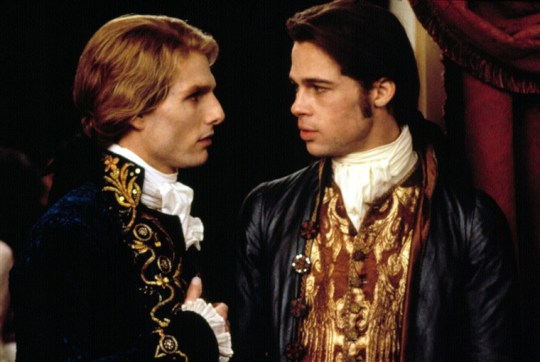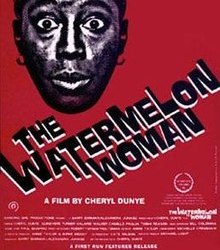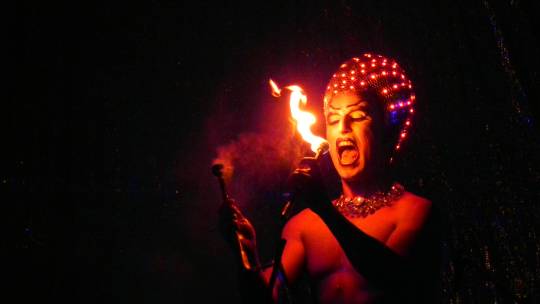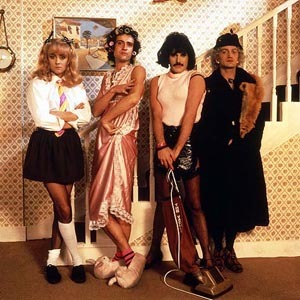Text
Week 11: Queer Anti-Futurism
Vampires, lots of vampires. This week we discussed how quote on quote bad queers, are represented in film. Typically in cinema, the bad queer has an investment in the death drive,especially with vampires. There is a very I am only here for fun,myself, I do not care about you and I do not care what happens mentality that comes with this. Because of this bad queers also do not want to be a family or desire to make a family. This connects with Interview With a Vampire because vampires can not reproduce. So they have a death drive and lack of family. Lee Edelman states that the Child represents the future of heteronormativity,the ability to have a child and reproduce is the ultimate privilege of this. In the movie, because vampires (bad queer) can not reproduce, there is not value put on the Child. Same sex attraction is seen as monstrous because of the inability to give birth and reproduce. The movie reflects all of this except for the fact that Louie tries to take on the roll of a father to a vampire child, which in the end ends up in demise. Which fuels the bad queer narrative. You can also see subtle hints of sexual attraction between the vampires, as Lestat deems Louie as his and there is a possessiveness over him. They also have intimate moments like sharing a woman for blood together.Then Louie and Armand have an undertone of a relationship as Armand is desperate to save and keep Louie to be his.

0 notes
Text
Week 10: Coming of Age and Coming Out
Queerness and sexuality is seen as fleeting and just a phase by many, but especially when it is in teens. When teenagers come out they are told they are confused and that it is just a phase because they are so young that they do not understand what they're feeling. Because of this it minimizes queer teens and how they identify. In the movie, Cameron is a lesbian teen who gets caught with her girlfriend at prom. She is sent to a Christian conversion camp, so there in lies two sections of intersectionality, sexuality and religion. There a camp councilor named Reverend Rick, is a converted gay man who runs the camp with his sister who was the one who converted him. In the camp you can see the obvious confusion and confliction with all the teens there. Their sexuality is being compared with very negative things, reinforcing negative stereotypes society has already put on them. Some of them try to convince themselves that being the way they are is actually a sin while others give up,one camper mutilates himself because of it. And while some of the tactics are outright homophobic, some of it is more subtle. Dr. Lydia uses manipulation of words, like the ice berg drawing and the negative comparisons she makes with the kids and their sexuality. She also uses more abrasive tactics like shaving off Adams hair,which is a very degrading thing to go through. Using all of these things are ways of getting the campers to conceal who they are so they can present as straight. You can see the constant unhappiness and confusion in Rev. Rick throughout the entire movie, who feels isolated and alone by his actions.

0 notes
Text
Week 9: Queering History
This week we learned about the queer women through out the history of cinema, what roles black women played. At the beginning of cinema, black women were presented as mamie types. These women were seen as care takers to children of white people,white people themselves and a source of homeliness and service. When you see stars in movies like Gone With the Wind and Imitation of Life. The women of color shown in these movies are servants of white families and their children. The maid in gone with the wind is a big heavy set woman who runs around the whims and needs of a rich white girl. The maid Annie in the Imitation of Life was the house keeper and caretaker of a white woman's daughter. They then go in business together based off the idea of her pancakes, and while it is both of them in it,Annie does more of the work and doesn't get as much credit. And this is the role that is played in so many movies for black women, the supporting role of the white women. They are also more demonized and sexualized by their bodies in society. In the Watermelon Woman Cheryl is a black queer woman making a movie about a white woman named Fae. And while Cheryl is a filmmaker which is seen as a power position, she is still below Fae, only because Fae is a white woman and therefor in society is deemed higher up in status. And while the two are a couple you can not really say they can be seen as equals when you analyze the movie as a whole.

0 notes
Text
Week 7: Lesbianism and Blackness
The theme this week was lesbianism and blackness and how it is represented in movies. Kind of like with brownness, blackness and lesbianism is seen differently in movies. They are underrepresented because in movies typically lesbians are shown as thin,white and feminine when that is not the case. The movie Pariah sheds different light to this stereotype by showing different types of lesbians. The movie shows a more masculine kind of lesbian which are known as studs, who present themselves more masculine. The movie shows intersectionality between race,class and sexuality. You have Alike who presents as more of a stud in the beginning. Throughout the movie you see her mothers struggle with this as she constantly uses religion to force her daughter into more feminine clothing. You can also see Alike is forced to be more masculine than she feels comfortable when her friend pressures her into wearing a fake penis in the club, which shows that the spectrum of how to present yourself is not just masculine and feminine no matter if you're straight or gay. The movie shows what is known to be a problem in a lot of american families, but more specifically black american families. The mothers strong rejection towards Alike being gay and using Christianity as crutch. You also see the rejection of Laura by her own family when she goes to tell them how shes doing in life and they have nothing to say to her, her only family she has being her sister. It is a sad reality that was needed to be shown. It also shows the importance of WOC filmmakers because you can see the difference in movies and their authenticity of their story.

0 notes
Text
Week 6: Queer Latnix
This week we discussed brownness and how it is represented in cinema. Jose Estaban states that brown people in general have a harder time fitting in to society because they do not belong to the black nor the white category. This was because of many different things but mostly because they went through different hardships. The way that femininity was related with brown women is because they held up jobs in the caretaker field, which is seen as a domestic and sexual role. So when you have queer brown women who do not fit into these roles, it makes it harder for them to be queer and brown. The movie we watched was Mosquita y Mari which follows the story of two young Latina lesbians. This movie showed intersectionalty between race,class,sexuality and religion. The girls live in a more poor area of town, Mosquita has religious parents as you can see through the decorum in the house. The two girls have a budding friendship that grown into more the more they hang out. This movie was different because it was not centered around sex or sexual activity between the girls. It was more about them being friends and there were hints of wanting more of that throughout the movie. Eventually there is a kiss,very small and innocent, which shows lesbian relationships in a new light that you usually dont see in lesbian centered movies. Their friendship is based off of Mosquita helping Mari become better in school and make better choices all around in life.

0 notes
Text
Week 5: The Troubles of Female Intimacy
This week we discussed the problematic ways the lesbian relationships were shown in cinema. We watched the movie Heavenly Creatures this week as well. Throughout cinema lesbian relationships are centered around the themes of sexual passion that eventually bleed into crime. In most movies you see, if there is a lesbian couple, they are very hyper sexualized and are usually shown through the male gaze (hence the hyper sexualization). In the movie Juliet and Pauline form a relationship which mostly focuses on their delusions and sexual urges. They live in their own fantasy world and feed off of each others delusions. They eventually devise a plan to kill their parents and go through with it. This movie perpetuates the idea that lesbians can only function sexually with each other and any mental connection they have has an underlying crazy side or mental illness. All of these things are discussed by Carroll Smith-Rosenberg in her book The Female World of Love and Ritual: Relations Between Women in Nineteenth-Century America and Lisa Duggans Sapphic Slashers: Sex, Violence, and American Modernity. These readings explain the demonetization of female relationships and the downplay as just friends in movies and in history. The crazy part about the Heavenly Creatures movie is that it really happened in real life and the movie described their relationship as something much more sexual than it actually was so that it could appeal to male audiences and sell.

0 notes
Text
Week 4: The Closet
This week we watched both The Celluloid Closet and The 7th victim. The Celluloid Closet was a summary of LGBTQ figures in the entertainment industry and the evolution of how this industry shaped and formed these figures to the public eye through media. We see this done in The 7th Victim with the character Jacqueline. This movie takes place in the 1940s back when homosexuality was not allowed to be presented on screen due to the codes. So because of this queer people were queer coded,either positively or negatively. It was usually negatively because it was used to reinforce bad ideals of homosexual people. You can see this by the way Jacqueline was portrayed, she was seen as evil in the plot of the movie,very odd and weird by her personality type. Her hair was dark with short sever bangs and she dressed in all black, embodying an evil looking stereotype. She also is in a satanic cult, pushing the narrative that people like her could only belong if they were part of an evil organization like a satanic cult. It pushed the narrative that people like her would not be accepted in normal aspects of life. She also had a very close relationship with one of the women in the cult who we can assume to be her lover. Towards the end of the movie she is forced to commit suicide, which proves the tired out narrative that queer people dont get happy endings in cinema.

0 notes
Text
Week 3: Paris Is Burning
This week we did not have class but we were assigned a movie/documentary to watch called Paris Is Burning as well as writing a summary of it along with Meyerowitz’s writings on ” Sex Change and the Popular Press ” . Paris is burning brings to light the culture,as well as the trials and tribulations of being queer (drag queen,gay etc.) in the 80s. It showed how most gay men came from broken homes,and formed their own families in this drag culture. They created their own families and competed against them in what they called balls. The range of what you could do was almost endless,but always resembled white upper class culture in some way. Because that was the ideal lifestyle. The movie brought to light their culture like voguing,slang like shade and reads etc. that no one knew about,later on exploiting and appropriating it as well. It also showed the uglier things, like what took most gay men’s life at the time which was hate crimes and AIDS. This movie flows into the reading by Meyerowitz because Meyerowitz discusses reassignment surgery. While not all men in the film wanted it, a lot of them talked and longed for the day they could get the surgery done. Reassignment surgery actually started in Germany and then made its way to America. Many doctors refused to do the surgery at first unless patients could show proof of inter-sexuality. Eventually doctors came around and more and more were willing yo do the surgeries because in the film none of the men talked about the difficulty of finding a doctor,just affording one.

0 notes
Text
Week 2: Queer Studies and Gender Binaries
This week we learned about the history behind the word queer, different binary constructs and how the can be harmful. We learned about Jagose and their stance on binary constructs. He said that queer was a zone of possibilities and that it could not be put into set defining categories. There is the essentialist and constructionist views on gender and sexuality. Essentialist is the idea that you were born this way and constructionist is that gender is a social performance. Constructionist views are harmful because people will assume that if you are preforming a certain role, they will assume you can change, negating the born this way theory and it is overall a toxic view to have. It is a view that backs up a lot of homophobia. Next we discussed Butlers view on gender trouble. This is seen in gender fiction, roles which society creates and puts femininity and masculinity into. Such as pink is for girls and blue is for boys. There is literally no scientific evidence backing up this idea, it is something we have decided in society, and when you go out of these two molds, you are scrutinized. Gender identity doesn't really have to do with biological aspects. Its how you choose to preform and identify to society. Every day actions,the way you dress,etc. show how you identify. This was highlighted in the movie we watched. In Orlando, he starts out as a young rich male,with no care for women and their feelings. He then wakes up a woman and seemingly has no issue with it. Instead of continuing to dress like a man he wears female clothing. He is faced with sexism, the loss of his fortune and is not bothered by it. He says screw what you think I should be as a woman, I will not marry or have a child just to keep a good life, so in this way he steps out of gender norms for a woman in that time. He also switches his attraction from female to male once he is a woman and takes no issue with it,making him either very fluid or just doing what he should as a now straight woman. It was also deemed problematic and transphobic that once his biological parts switched that he then identified as female, it was discussed that just because you have certain biological parts does not mean you need to identify with them.

0 notes
Text
Week 1: Repression Theory
This week we talked about the Repression Theory and the may ways it can be used. The most prominent thing about the Repression Theory is that you can repress someone silently. You can also silence someone through speech. This theory explains all the ways queer people have been repressed in the past and sometimes even now. At the start of the 17th century silence through speech started and was used to put sex in a negative light. Towards the 18th and 19th century there was a focus and obsession on talking about queerness, but in a negative light. Repression was used on queer people because institutions of power like the church or doctors were constantly talking about it, but in a negative light. There was the “confess your sins” aspect used by the church to make people feel guilty and silence them into feeling negatively for being queer. This was also used in court hearings or in doctors offices. I don't think we discussed it but I know lobotomy and conversion therapy was a common practice used on queer people back then. We then watched Different From Others to see how the Repression theory was being actively used back then. The film showed a gay couples struggles back in Nazi Germany and all of the issues they faced to an extent. You couldn't outright claim to be gay in film back then so there were subtle hints at it throughout the film. For example the fact that the two gay men were artistic, the clothes they wore were androgynous and well tailored. This was the beginning of queer coding in film. In the film you saw repression through silence in the scene where Paul kisses a fellow classmate in boarding school. A teacher walks in and sees this, and based on the reaction given (of disgust) Paul has to push those feelings down and aside for years until he meets Kurt. Something that intersected with Foucault's theory was the fact that science was used to try to normalize homosexuality in the movie. It was very surprising to see that ideal being taken on in such a close-minded era.

( I wanted to use this image from Queen's song I Want To Break Free,because it has so many elements mixed in to it. This song meant so much and so many things to so many people, it was a song of liberation, and the band received a lot of backlash for being dressed as women in the video. Since the topic of this entry was repression and we are now starting to break free from those kinds of standards, the first thing that came to my mind was this.)
1 note
·
View note